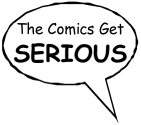

| Marvels. Written by Kurt Busiek. Illustrated by Alex Ross. New York: Marvel Comics, 1994, 1999. 1v. (unpaged). $19.95. ISBN 0-7851-0049-0. |

|
GENRES: AUDIENCE: NOTE: This book collects issues #0-4 of Marvels. SYNOPSIS: Over the next few weeks, the Human Torch flies around doing heroic things that are duly recorded and commented upon by ordinary New Yorkers. Phil is absorbed by these events and normal humanity's insignificance in the face of these "Marvels"; he pays little attention to Doris's wedding plans. Then, one day, the Human Torch and the Sub-Mariner face off over Manhattan. The normals helplessly watch the destruction until the two are brought together by a policewoman who understands the Sub-Mariner's gripes. Of course, neither Marvel is held responsible for the damage. Phil is so disturbed by his own fragility that he puts off the wedding. Time passes. The Nazi machine rolls across Europe. Captain America emerges and wins headlines and fans across the country. Phil runs into Doris attending a movie with another man, and they see a newsreel about how the Torch and the Sub-Mariner have been battling the "Nazi-Jap war machine." [This takes place before Pearl Harbor.] Suddenly the two are complete heroes. Phil and Doris get back together. Then the Sub-Mariner inexplicably turns on the entire world and arranges for a tidal wave to hit New York City. Phil, desperate to get a photograph of the wave, risks his life to take a picture. He also photographs the Torch and the Sub-Mariner fighting, and during the fight, he's hit in the face with a brick. He awakens in a hospital, having lost an eye. But all is well in New York: the Sub-Mariner is back on the side of the angels, and "reparations [are] being made." Years pass. The regular war is long over, but the wars between heroes and villains are nearly constant in New York City. Marvels routinely make the front page of the newspapers. Normals watch on the periphery. Sightings are common, as are innocent bystanders (though of course no one is ever killed). But a new threat has arisen: mutants. Phil is initially on the side of the anti-mutant forces, again terrified that he won't be able to protect his family from the "dark side" of the Marvel phenomenon. Then he discovers that his two daughters have been sheltering a young mutant girl, and he cannot bring himself to hate them any longer. When riots against mutants break out downtown, he scrambles to get back to his house; he finds his family safe, but the mutant girl has fled rather than see his family get hurt. All they can do is hope for her. Later, Phil works on a book of his Marvel photographs. The Avengers are declared a public menace because of something-or-other, though in short order their reputation is restored. New York is flooded by a villain but is saved by the Avengers. [Yes, things move this quickly in this book.] Various heroes and villains do things. Public opinion changes almost every day. Galactus threatens to eat up the world, but is thwarted by the Fantastic Four, though the normals are pretty frightened in the interim, believing the world really will end. In the aftermath, J. Jonah Jameson of the Daily Bugle calls Galactus a hoax. Phil is disgusted with New Yorkers for blaming instead of canonizing the FF. In the final chapter, Phil gets involved with Spider-Man's supposed murder of policeman George Stacy. He speaks to various individuals about it, including the then-jailed Dr. Octopus and Gwen Stacy, George's daughter. He is horrified witness to Gwen's kidnapping by the Green Goblin, her fall, and Spider-Man's fruitless attempt to save her. Burned out and disillusioned, Phil retires to spend his golden years with Doris. The book includes essays by Stan Lee, Kurt Busiek, Alex Ross, and Scott McCloud, longtime friend of Busiek EVALUATION: The first thing that struck me was the painted art, which was splendid and in some cases astonishingly realistic. The panel with Spider-Man climbing past the window and startling the reporters was a wonderful human moment. There are perhaps too many "E.T." moments where people look up in the sky in awe, smiling and cheering or simply staring at some phenomenon or other. But I have no serious complaints with Ross's contributions. But art is one thing; story is my main focus. So I started to read. Oh, how disappointing. Oh, how trivial. For one thing, like the recent nadir musical The Civil War, which tried to cover the entire war in about two hours, Marvels tries to cram several decades of Marvel Universe history into one book. Sorry--it's not possible. The rapid-fire presentation of So-and-So Saves the World! and So-and-So Accused of Murder! and So-and-So Gets Married! gets numbing really fast. However good a writer Busiek might be, he was forced to tell this story within the constraints of the corporate party line and already-told stories of the past. Among other things, this meant that all of the unrealistic behaviors of Marvel Silver Age normals were perpetuated yet again. No one swears. In general, the dialogue is usually pretty dumb (e.g., when Phil worries that it's not healthy for his daughters to idolize the Marvels, his wife scoffs, "Oh tosh. They're healthy as two monkeys.") Whenever a Marvel passes by, everyone spouts the current set of beliefs about that character; no one ever deviates from the prevailing "wisdom" (except the somehow-more-thoughtful-than-everyone-else Phil). Every hero-related activity makes the first page of the newspapers. Every display of superpowers is treated as if no one has ever seen these things before. Etc. If Phil had been a more believable or interesting character, that would have helped. Unfortunately, he's little more than a bland presence obsessed with Marvels. This is all standard superhero stuff, and I wouldn't be making such an issue about it if this book wasn't supposed to have been the stories retold from the average person's perspective. There's a lot of potential in that viewpoint, but Marvels isn't the place where it's realized. Trouble is, Marvel Universe normals behave so non-normally that they simply cannot be passed off as real people. Funny--I'm willing to suspend disbelief when it comes to superpowers, but not over matters of normal human behavior. Of course, we have benchmarks for the latter. Well, I hate to go against Scott McCloud and a bunch of prior critical praise, but this book is a huge disappointment. From a Marvel context I suppose it's innovative and realistic; from an outsider's point of view... well, let's just say that "Marvel innovation" is an oxymoron. Its reputation demands a recommendation for superhero collections. |
Return to Rational Magic Home
